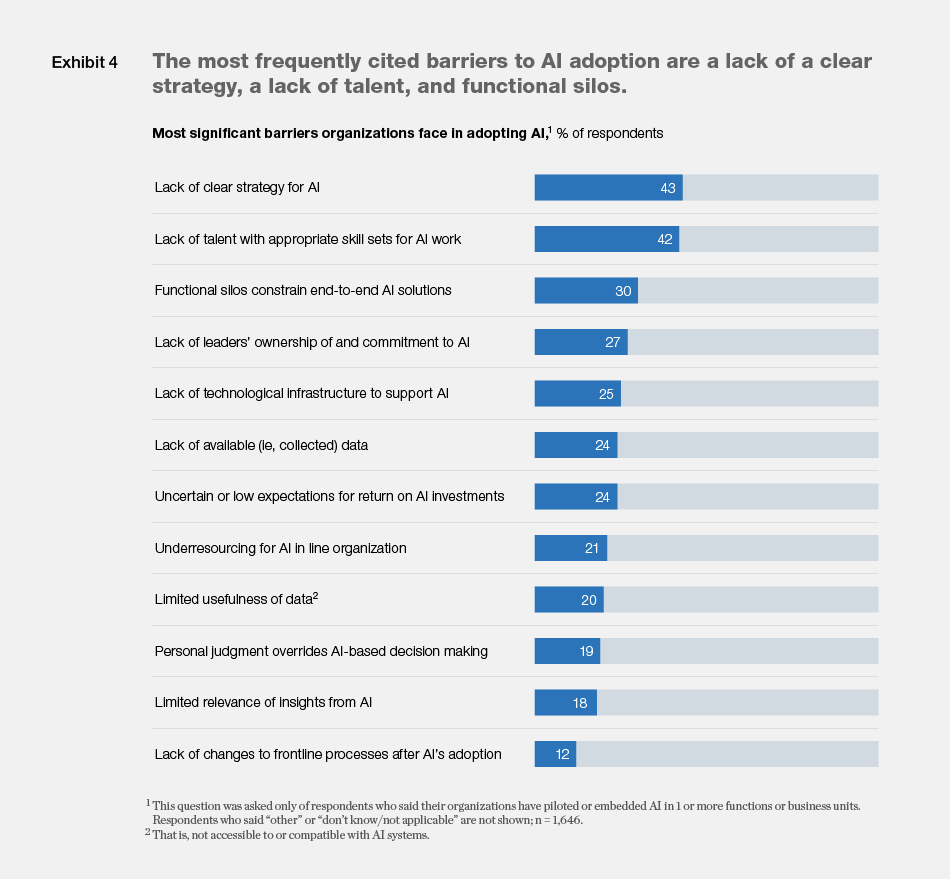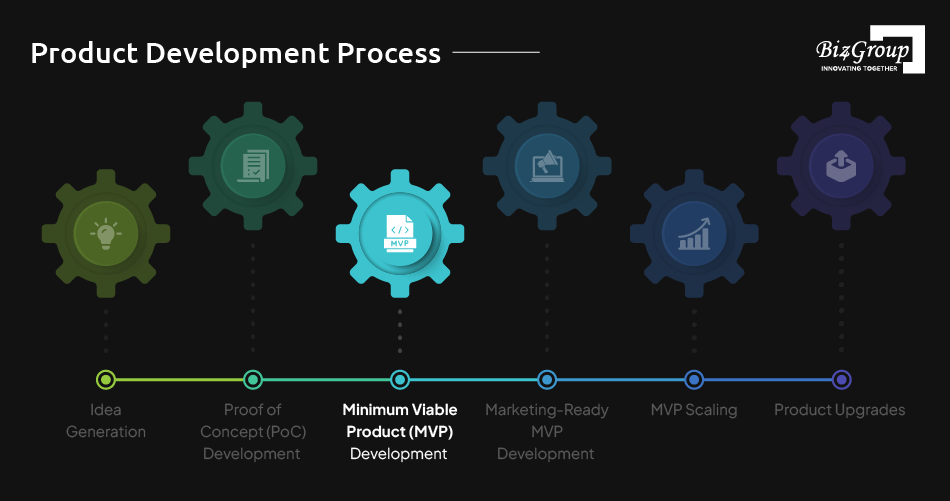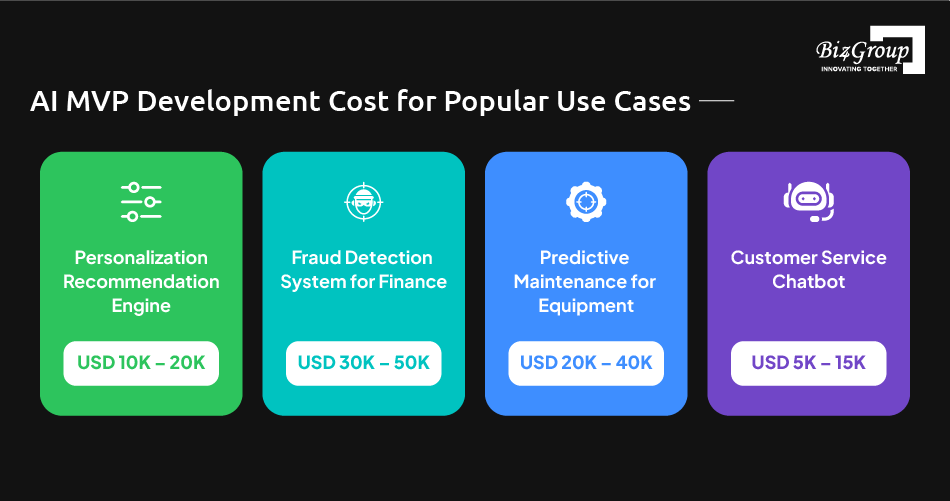Basic AI Chatbot Pricing: A simple chatbot that can answer questions about a product or service might cost around $10,000 to develop.
Read More
According to research by RAND Corporation, more than 80 percent of AI projects fail, twice the rate for IT projects that don’t even include AI. This high failure rate is a strong indication of why an intelligent strategy should be planned for AI development. However, only 17% of organizations have a clear plan on how to use AI and just 18% have a plan for managing data, which must happen for AI projects.

Source: Mckinsey
With these challenges, it’s important to start small to mitigate risk, while controlling costs. Validating an AI concept is the best first step before betting all your chips in. MVP gives an opportunity to show the advantages of AI applications on a smaller scale and adjust before moving on to the broader scale. So, how much does it cost to build an MVP for AI applications? So, let's look at an example of how this works: why you need MVP and what factors drive the cost of MVP.
A Minimum Viable product (MVP) is the bare minimum version of your product as you test out your idea to find early adopters. For AI projects, building an MVP is crucial for several reasons.
The problem lies in that many organizations who are looking to implement AI, struggle to do so. And in fact, 43 percent of companies cite a lack of AI strategy as the biggest barrier. MVP helps you overcome the issue by giving you a framework for testing ideas before embarking on full-scale development. This grants businesses the possibility to learn from early feedback and validate the AI model’s value.
The reason for an MVP is the high rate of AI projects failing. This helps developers show what AI can do on a smaller scale, which makes it easier to defend that investing more later. Minimizing the financial investment required initially, starting with an MVP means businesses are never overly invested in something that hasn’t been validated.
Here is where MVP development stands in the product development process:

The pricing for building an MVP for AI applications depend on a few key things. Understanding these factors can help manage the overall MVP development cost and avoid overspending. Here’s a breakdown of the main cost drivers:
The more complex the problem your AI application is trying to solve, the higher the cost to build an MVP. So, for example, a simple chatbot will likely cost somewhere between $5,000 and $10,000, whereas an AI model for transparent real-time fraud detection might need, for example, advanced algorithms and requires real-time data processing and can cost something around $30,000 – $50,000. Whereas AI chatbot for enterprises would cost more than $100,000.
Data is the fuel for AI. If your MVP requires extensive data cleaning, preparation, or collection, the MVP app development cost will increase. For instance, data preparation for Predictive Maintenance in Manufacturing may be costly because it involves sourcing and preparing large datasets, and a chatbot may only need a very little amount of data preparation.
Another significant cost factor is hiring AI developers, data scientists, and machine learning engineers. The lack of in-house AI expertise can lead to hiring external AI consultants or AI development firms, which can add to the MVP cost. For complex projects, salaries for experienced AI developers fall between $100,000 and $200,000 per year.
The choice of AI platforms, cloud services, and computing resources plays a major role in determining the MVP prototype cost. Flexibility can be gained from deploying and using cloud services such as AWS or Google Cloud, but the ongoing costs follow expenses tied to usage. If your MVP includes real-time processing, for example, Fraud Detection in Finance, infrastructure costs are higher.
Many MVP products are built in a shorter timeframe, so the costs can increase. A more complex AI MVP may take longer to develop, which increases the overall cost to build MVP. Streamlining the development process and focusing on essential features can reduce the timeframe and associated costs.
| Stage-Wise MVP Development Cost for AI Products | |
|---|---|
| MVP Development Stage | Estimated Cost Range |
| Market Research | $1,000 - $2,000 |
| UI/UX Design | $1,000 - $2,000 |
| Wireframe Design | $1,000 - $5,000 |
| Backend Development | $5,000 - $15,000 |
| Frontend Development | $3,000 - $10,000 |
| Data Preparation & Integration | $3,000 - $8,000 |
| Testing & QA | $2,000 - $6,000 |
| Deployment & Maintenance | $1,000 - $5,000 |

Depending on the real use case, the cost of developing an MVP for AI applications can be significantly different. Below are some common AI use cases and their estimated MVP development cost:
Estimated MVP Cost: $10,000 to $20,000
Core Features: A product recommendation engine that recommends things a user should buy based on past user behavior and purchase history. It also includes real time analytics to track and adjust recommendations.
The MVP cost in this case involves building algorithms to analyze customer data and developing a scalable infrastructure for real-time updates.
Estimated MVP Cost: $30,000 to $50,000
Core Features: Fraudulent transaction anomaly detection, real time monitoring, and risk scoring for prioritizing high-risk activities.
This use case requires a higher MVP app cost due to the complexity of real-time data processing and the need for advanced machine learning models that can identify subtle patterns in financial transactions.
Estimated MVP Cost: $20,000 to $40,000
Core Features: Health monitoring of monitoring equipment, predicting machine failures, and scheduling maintenance based upon data driven insights.
Developing this type of MVP involves collecting large datasets from machinery, which can increase the cost to build MVP due to the need for data integration and analysis tools.
Estimated MVP for a custom chatbot development would cost: $5,000 to $15,000
Core Features: Be able to process user queries using Natural Language Processing (NLP) to understand and respond to the queries, predefined response templates and possess the capability to learn continuously to get more accurate.
The MVP prototype cost for chatbots is generally lower due to the availability of pre-built NLP models and APIs, which can speed up development and reduce costs.

When planning the development of an MVP for AI applications, it's crucial to collaborate with experienced professionals who can navigate the complexities of AI integration. Partnering with one of the Top MVP Development Companies in the USA ensures that your project benefits from industry expertise, leading to a robust and market-ready product. These companies specialize in rapid prototyping, iterative development, and have a proven track record in delivering successful AI-driven MVPs. Engaging with such experts not only accelerates your time-to-market but also enhances the quality and scalability of your AI application.
Building an MVP for an AI application requires a process so that your product solves a real problem, stays within budget, and generates value. Below are the key steps involved in developing an MVP for AI applications:
The main question you must ask yourself before you even think about building an MVP is what the main problem you are trying to solve with the AI application you want to develop.
A quick, impactful problem should be focused on because that’s what people are looking for and that’s how you can bring value. Knowing what they had, it is critical to research and narrow down on a core problem area as only 17% of companies have mapped out their AI opportunities.
Here are some examples of AI use cases and their primary problems:
Chatbots for Customer Service: The problem fundamentally boils down to doing so in a way that doesn’t overwhelm support teams. High volumes of repetitive questions are a challenge that businesses often find themselves in, and a AI-powered chatbot can step in to manage these inquiries, with instant responses and freeing up human agents for more complex issues.
Predictive Maintenance in Manufacturing: The biggest issue is to reduce equipment downtime. AI can predict that machinery will fail at some point in the future so companies can schedule maintenance before breakdowns and repair costs.
Fraud Detection in Finance: The problem in financial institutions is to detect fraudulent transactions on time. An AI model can help us in analyzing the transactional pattern and finding out any anomaly which might lead to minimize the financial loss caused in fraud.
Personalized Recommendations in E-commerce: The problem here is to give the user relevant product recommendations to enhance the user experience and boost the sales. By analyzing customer’s behavior and preferences, AI recommendation systems recommend products that are more likely to appeal to customer's individual interests.
Next key step in building an MVP for AI is figuring out what to build that gives the most value. These core features should be about solving the first step’s main problem. By concentrating on a few key functionalities, you can manage the cost to build an MVP more efficiently and ensure quicker development.
Let’s explore the core features for different use cases so that you get an idea of how to find core features for your MVP:
Feature 1: The central feature in product recommendation engine is it suggests products to users based on querying and past purchasing history.
Feature 2: Grouping users into categories based on the behavior to offer more accurate suggestions.
Feature 3: Tracking user behavior dynamically in real time to dynamically adjust its recommendations.
Feature 1: An Anomaly Detection – Localization of strange patterns in financial transactions to flag plausible instance of fraudulence.
Feature 2: Priority Investigation – Prioritizing investigations of higher risk activity through assigning a risk score to each transaction.
Feature 3: Continuous monitoring of transactions while fraudulent behavior happens (real-time monitoring).
Feature 1: Predictive Maintenance – Monitoring the chances of equipment failure in real-time.
Feature 2: Failure Prediction – Predict whether a machine is likely to fail using historical data, and then perform preventive maintenance!
Feature 1: Natural Language Processing (NLP) - The ability of the chatbot to respond to customer queries in natural language.
Feature 2: Quick Response – Pre predefined Response Templates. Using pre-programmed responses for common customer service queries to provide quick resolution to customer requests.
Feature 3: Continuous Learning – Continuous improvement of the chatbot by letting it learn from user interactions.
Securing the right data is one of the most critical aspects of creating an MVP for AI applications. Data Strategy, even more so as 18% of organizations have a hard time with formulating their plan for obtaining data upon which their projects flow.
When you’re building your MVP, you can’t afford to have any dirty data, and the data you collect has to be clean enough, relevant, and sufficient for training the AI models. The data must be structured and prepared carefully, as poor-quality data can lead to incorrect predictions and increase the MVP development cost due to the need for reprocessing and model adjustments.
For example:
To train recommendation algorithms in Personalized Recommendations for E-commerce, data about with how users browsed, what they purchased, are needed.
For Fraud Detection for Finance, building accurate fraud detection models requires transactional data provided transaction types, historical fraud data and timestamps.
Operational Data of machinery, their temperature, pressure etc. along with their historical breakdown record are the required input for reliable predictions of the manufacturing Predictive Maintenance.
Customer Service Chatbots have to be fed through training by collecting the chat logs, customer feedback, and queries to your product on the other hand.
Proper data collection not only improves the performance of your MVP but also helps keep the AI MVP app development cost under control by reducing the need for retraining and error correction.
Choosing the technology stack for your AI MVP is important and it needs to be able to balance performance and cost. The tech stack you select will determine how efficiently your AI model can run, how scalable it will be, and how much the cost to build an MVP will vary.
For AI applications, you need to focus on two key components: the framework and infrastructure. Here’s a breakdown of important choices for each:
AI Frameworks: TensorFlow, PyTorch and Scikit for example are considered common AI frameworks. They’re used widely for building machine learning models, according to the complexity of the problem. As a case in point, TensorFlow works well with more advanced models like deep learning, whereas Scikit-learn is essentially perfect for simple jobs such as classification.
Cloud Platforms: Infrastructure for deploying AI models at scale can be found in cloud services such as AWS, Google Cloud or Microsoft Azure. They also have tools to help manage data pipelines, storage and real time processing vital to jobs like Fraud Detection in Finance and Predictive Maintenance in Manufacturing.
Selecting the right combination of frameworks and platforms ensures that your MVP is scalable and capable of handling the necessary computations without over-inflating the MVP cost. Additionally, leveraging third-party APIs and pre-built models can reduce development time, which in turn lowers the cost to build MVP.
After selecting the right technology stack and defining the core features, you get to that all important working prototype. This prototype will not include all your final AI application features, but will be completely functional, delivering the essentials.
For example:
A typical prototype in Personalized Recommendations for E-commerce might be limited to a basic recommendation engine recommending products from a past user’s activity.
The prototype for financial fraud could be used to detect anomalies in transactions without real time monitoring of course.
In Predictive Maintenance on Manufacturing, the MVP could be to monitor just one key piece of machinery and predict when maintenance is going to be needed.
The first version of Chatbots in Customer Service could respond just to a few predefined customer queries.
The goal at this stage is to build something functional but not fully polished, which keeps the MVP prototype cost lower. Creating an initial version quickly gives you a chance to get some early feedback and refine the features, so there is no risk of wasting your time on something that won’t work.
Building the prototype will give you a clearer idea of how much MVP app cost you’re likely to incur when expanding the project further.
Iterative testing is the last step in the development of your AI MVP. So, this means that we are running the MVP in real world settings, getting feedback from the users and therefore refining the model. Continuous testing allows the AI model to work smoothly and facilitate in handing the users’ needs similarly.
Iterative testing ensures that your MVP continuously improves based on real feedback, minimizing the risk of failure and optimizing the cost to build an MVP. The ongoing testing process also keeps the MVP app development cost predictable by addressing potential issues early before scaling the application.

Building an MVP for AI apps is a solid way to cut down on risk and expenses. By focusing on essential features, you can reduce the cost to build an MVP and gather valuable user feedback. With simple projects like chatbots, you can expect to pay between $5,000 and $15,000, while more advanced applications (such as fraud detection) can run you anywhere from $30,000 to over $75,000.
To ensure the success of your AI MVP, you should hire a AI consulting service provider. Their expertise can guide the project, improve resource utilization, and increase the likelihood of a successful AI solution.
IN YOUR BUSINESS FOR FREE
Our website require some cookies to function properly. Read our privacy policy to know more.